1 of 19
Download to read offline

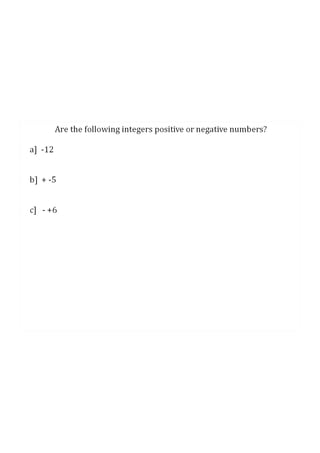


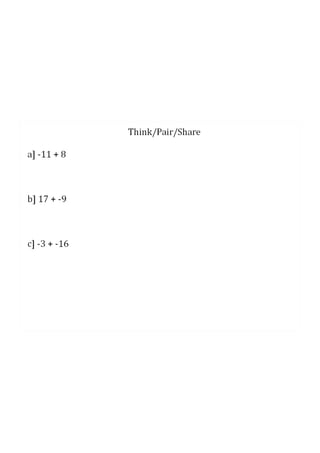

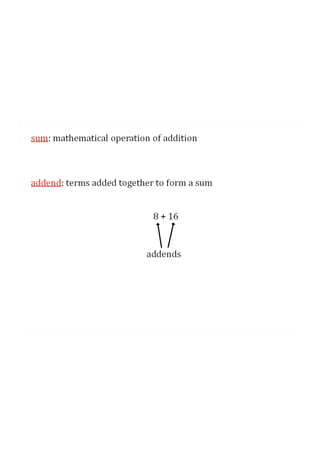



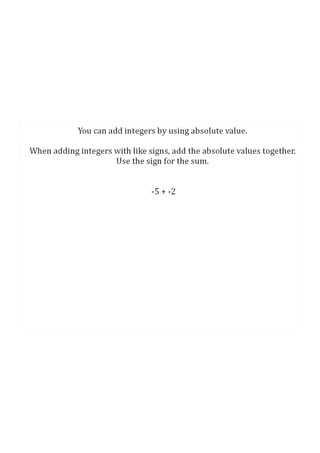



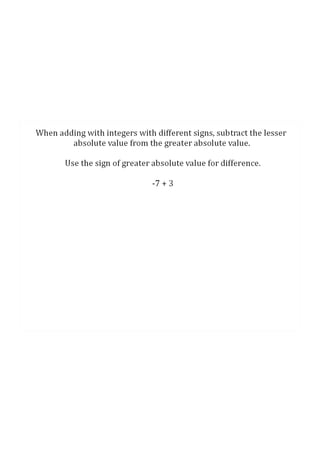




Ad
Recommended
1.4 Data Collection & Sampling
1.4 Data Collection & Samplingmlong24
╠²
The document identifies four basic sampling techniques: random sampling which uses chance methods to select samples, systematic sampling which selects every k-th subject, stratified sampling which divides the population into groups and samples from each, and cluster sampling which divides the population into clusters and randomly selects some clusters. The objective is to identify these four basic sampling techniques for collecting data.1.5 Observational vs. Experimental
1.5 Observational vs. Experimentalmlong24
╠²
This document explains the key differences between observational and experimental studies. Observational studies involve observing phenomena as they occur naturally, while experimental studies involve manipulating variables and determining their effects. It defines related concepts like independent and dependent variables, treatment and control groups. It notes advantages of experimental studies like controlling subject selection and variable manipulation, and disadvantages like artificial settings and potential confounding variables.1 3 Variables and Types of Data
1 3 Variables and Types of Datamlong24
╠²
This document discusses different types of variables and levels of measurement. It defines qualitative and quantitative variables, as well as discrete and continuous variables. There are four levels of measurement for variables: nominal, ordinal, interval, and ratio. Nominal variables classify without order, ordinal can be ranked but differences are unknown, interval are ranked with precise differences but no true zero, and ratio have a true zero and allow for ratios. The document provides examples for each variable type and level of measurement.1.6 Uses and Misuses
1.6 Uses and Misusesmlong24
╠²
The document discusses the proper and improper uses of statistics. It explains how statistics can be used to describe data, compare data sets, determine relationships, and test hypotheses. However, it also outlines several ways statistics can be misused, such as to sell ineffective products, prove false claims, or induce fear in audiences. Specifically, it describes how using small, biased, or inconvenient samples, ambiguous averages, detached statistics without comparisons, implied connections without proof, misleading graphs, and biased survey questions can distort the truth.1.1-1.2 Descriptive and Inferential Statistics
1.1-1.2 Descriptive and Inferential Statisticsmlong24
╠²
Statistics involves collecting, organizing, and analyzing data to draw conclusions. Descriptive statistics summarize and describe data, while inferential statistics generalize from samples to populations through estimation, hypothesis testing, and prediction. The chapter introduces key concepts including variables, data, random variables, data sets, data values, populations, samples, descriptive statistics, probability, and inferential statistics. Students are assigned problems applying these statistical concepts.2.3 Histogram/Frequency Polygon/Ogives
2.3 Histogram/Frequency Polygon/Ogivesmlong24
╠²
This document discusses different types of graphs used to represent frequency distributions: histograms, frequency polygons, and ogives. It provides examples and instructions for constructing each graph type. Histograms use vertical bars to represent frequencies, frequency polygons connect points plotted for class midpoints, and ogives show cumulative frequencies. The document also discusses relative frequency graphs and common distribution shapes like bell-shaped, uniform, and skewed. It assigns practice constructing different graph types from example data.2.4 Other Types of Graphs
2.4 Other Types of Graphsmlong24
╠²
This document discusses different types of graphs used to represent data including Pareto charts, time series graphs, and pie charts. It provides details on how to construct each graph type, including arranging bars from largest to smallest frequency for a Pareto chart and dividing a circle into wedges according to category percentages for a pie chart. Examples and steps are given for drawing each graph. Additional topics covered include stem and leaf plots and comparing data sets using different graph types.2.1-2.2 Organizing Data
2.1-2.2 Organizing Datamlong24
╠²
This document discusses organizing raw data from a study on employee commute distances into a grouped frequency distribution. The raw data consists of the number of miles each employee traveled to work each day. To draw useful conclusions, the data is organized into a table with class intervals, tallies of data points within each interval, and cumulative frequencies. The document provides guidelines for determining class limits and widths to properly categorize the data while maintaining mutually exclusive and exhaustive classes of equal size. Organizing data into a frequency distribution in this way facilitates analysis and presentation of the distribution's shape.3.5 Exploratory Data Analysis
3.5 Exploratory Data Analysismlong24
╠²
This document discusses exploratory data analysis techniques including boxplots and five-number summaries. It explains how to organize and graph data using histograms, frequency polygons, stem-and-leaf plots, and box-and-whisker plots. The five important values used in a boxplot are the minimum, first quartile, median, third quartile, and maximum. An example constructs a boxplot for a stockbroker's daily client numbers over 11 days.3.3 Measures of Variation
3.3 Measures of Variationmlong24
╠²
This document discusses measures of variation in data, including range, variance, and standard deviation. It provides examples of calculating these measures for both individual data points and grouped data. The key measures are:
- Range is the highest value minus the lowest value.
- Variance is the average of the squared distances from the mean.
- Standard deviation is the square root of the variance, measuring average deviation from the mean.
- Coefficient of variation allows comparison of variables with different units by expressing standard deviation as a percentage of the mean.
- Chebyshev's theorem and the empirical rule specify what proportion of data falls within a given number of standard deviations of the mean.3.4 Measures of Position
3.4 Measures of Positionmlong24
╠²
This document discusses various measures of position such as percentiles, quartiles, and standard scores. It provides examples of how to calculate percentiles, quartiles, z-scores, and identify outliers. Key points covered include how to interpret percentiles and z-scores, how to calculate quartiles and find values corresponding to specific percentiles, and the procedure for identifying outliers in a data set.3.1-3.2 Measures of Central Tendency
3.1-3.2 Measures of Central Tendencymlong24
╠²
This document discusses measures of central tendency including the mean, median, and mode. It provides examples of calculating the mean from raw data sets and frequency distributions. The median and mode are defined as the middle value and most frequent value, respectively. Methods for calculating each from both types of data are shown. Other measures covered include the midrange and the effects of outliers. Shapes of distributions are discussed including positively and negatively skewed and symmetric. Practice problems are provided to reinforce the concepts.4 3 Addition Rules for Probability
4 3 Addition Rules for Probabilitymlong24
╠²
This document discusses the addition rules for probability of compound events. It defines mutually exclusive events as events that cannot occur at the same time, and explains that for mutually exclusive events A and B, the probability of A or B is equal to the probability of A plus the probability of B. For events that are not mutually exclusive, the probability of A or B is equal to the probability of A plus the probability of B minus the probability of A and B occurring together. Several examples are provided to illustrate calculating probabilities using these addition rules.4.1-4.2 Sample Spaces and Probability
4.1-4.2 Sample Spaces and Probabilitymlong24
╠²
The document defines key concepts in probability theory, such as probability experiments, outcomes, sample spaces, events, classical probability, empirical probability, and subjective probability. It provides examples of how to calculate probabilities of simple and compound events using classical probability methods, including determining probabilities using fractions or decimals and interpreting "and" and "or" probabilities.2.1 Phy I - Displacement and Velocity
2.1 Phy I - Displacement and Velocitymlong24
╠²
This document discusses displacement, velocity, and related concepts. It begins by defining displacement as the straight-line change in an object's position, measured in meters. Displacement is distinguished from distance traveled, as displacement considers only the net change in position regardless of path. Equations for calculating average velocity from displacement and time are provided. Positive and negative displacement and velocity are described based on direction of motion. Instantaneous velocity is defined as the velocity at a specific point and can be determined from the slope of a tangent line on a position-time graph. Sample problems and practice questions are included for students to calculate displacement and average velocity in various scenarios.2.2 Phy I - Acceleration
2.2 Phy I - Accelerationmlong24
╠²
This document discusses acceleration and kinematic equations for objects experiencing constant acceleration. It defines acceleration as the rate of change of velocity and introduces the average acceleration equation. It then derives and explains the equations for displacement given constant acceleration using the relationships between velocity, acceleration, displacement and time. Sample problems demonstrate applying the equations to calculate values when given acceleration, initial/final velocities, displacement or time. The key equations covered are for average and final velocity, and displacement given constant acceleration.1.2 Measurements in Experiments
1.2 Measurements in Experimentsmlong24
╠²
This document provides an overview of measurements and significant figures in physics experiments. It defines key terms like accuracy, precision, and significant figures. Accuracy refers to how close a measurement is to the true value, while precision describes the exactness of a measurement. Significant figures indicate the precision of a measuring device. The document reviews proper techniques for measurements, unit conversions using dimensional analysis, and calculating with significant figures in additions, subtractions, multiplications and divisions. Students are expected to learn the basic SI units, prefixes, and how to determine the number of significant figures in given values and calculations.1.1 What is Physics?
1.1 What is Physics?mlong24
╠²
Physics is the study of the physical world and how it behaves. It can be broken down into seven main categories including mechanics, thermodynamics, optics, and electromagnetism. The scientific method involves making observations, formulating hypotheses, testing with experiments, and drawing conclusions. Models are used to simplify complex physical systems and guide hypothesis building and experimental design by focusing only on relevant characteristics.1.3 The Language of Physics
1.3 The Language of Physicsmlong24
╠²
This document provides an introduction to the language of physics. It discusses how mathematical equations are used to describe physical phenomena and symbols commonly used in equations. Examples are provided on how to interpret equations and use dimensional analysis to check if equations are dimensionally consistent by evaluating the dimensions on each side. Students are assigned textbook problems evaluating physics expressions using these concepts.AP Physics 1 - Introduction
AP Physics 1 - Introductionmlong24
╠²
This document provides an introduction to physics, covering several key topics:
- The main areas of physics are mechanics, thermodynamics, vibrations and waves, optics, electromagnetism, relativity, and quantum mechanics.
- Dimensional analysis is used to determine whether equations are valid by checking that quantities with the same dimensions can be combined and that both sides of an equation have the same dimensions.
- Symbols like ╬ö, ╬Ż, g, x are commonly used in physics equations to represent concepts like change, sum, gravitational acceleration, and displacement.Color & Marketing
Color & Marketingmlong24
╠²
Branding uses colors, symbols, and designs to identify companies and convey instant messages to consumers. John Deere's iconic green and yellow symbol is instantly recognizable due to their strategic use of color in branding. McDonald's similarly uses the stimulating color red and friendly color yellow in their logo and marketing to trigger hunger and attract customers. Facebook's blue and white logo was influenced by Mark Zuckerberg's colorblindness but blue is also known to convey qualities of trust, loyalty, and communication that are suitable for a technology company. Color plays an important role in branding by increasing brand recognition and subliminally influencing consumer perceptions.Color & Vision
Color & Visionmlong24
╠²
The document discusses color and vision. It explains that white light contains all colors of the visible spectrum and how the eye sees color using cone and rod cells in the retina. There are two theories on whether black and white are colors, one stating they are not colors as they are the absence of light, and the other stating black is a color as it involves pigmentation. The document also covers color blindness, color vision tests using plates, and some fun facts about different colors.Maps as Models of Earth
Maps as Models of Earthmlong24
╠²
This document provides information about key concepts for reading and understanding topographic maps, including:
- Contour lines connect points of equal elevation and are used to show elevation changes on topographic maps. Closer contour lines indicate steeper slopes.
- Relief, elevation difference between highest and lowest points in an area, determines the contour interval or spacing between lines.
- Contour lines have set rules like never crossing, being V-shaped in valleys, and forming closed circles around peaks.Nature of Light
Nature of Lightmlong24
╠²
This document provides an overview of the nature of light. It begins by describing light as an electromagnetic wave that consists of vibrating electric and magnetic fields and does not require matter to travel through. It then discusses key characteristics of light, including its speed, the importance of light from the sun as an energy source, and the electromagnetic spectrum. The document proceeds to describe different types of electromagnetic waves, including radio waves, microwaves, infrared waves, visible light, ultraviolet light, x-rays, and gamma rays. It provides examples of uses for each type of wave and notes both beneficial and harmful effects of exposure.Chemical Compounds
Chemical Compoundsmlong24
╠²
This document discusses acids and bases. It defines acids as compounds that increase hydronium ions in water and bases as compounds that increase hydroxide ions in water. Strong acids and bases fully dissociate in water, while weak acids and bases only partially dissociate. The pH scale is used to measure how acidic or basic solutions are. Neutralization reactions occur when acids and bases react, forming water and salts. Common acids and bases have various industrial and household uses.5.2 Energy - Applied Physics
5.2 Energy - Applied Physicsmlong24
╠²
This document discusses different forms of energy including kinetic energy, potential energy, gravitational potential energy, elastic potential energy, and mechanical energy. It provides formulas and examples for calculating each type of energy. Kinetic energy is related to an object's motion while potential energy depends on an object's position or condition. Mechanical energy is the total of an object's kinetic and potential energies. Sample problems are included for calculating energies in situations involving a moving bowling ball, stretched springs, and a stuntman attached to a bungee cord.The Flow of Fresh Water
The Flow of Fresh Watermlong24
╠²
This document provides an overview of key concepts about rivers and water systems from an Earth Science textbook. It begins by describing how moving water causes erosion and shapes the landscape. It explains the water cycle and defines important river features like tributaries, watersheds, and gradients. Later sections discuss how rivers deposit sediment to form features like deltas and floodplains. It also explains groundwater systems, describing aquifers, springs, wells, and how erosion can form caves and sinkholes. The document concludes by discussing water pollution, water treatment, and conservation strategies.Climate SG Key
Climate SG Keymlong24
╠²
This document provides a climate study guide with questions and answers about various climate-related topics. It discusses how temperature and precipitation are used to classify climates and describes the characteristics of different biomes. It also addresses how factors like mountains, ocean currents, greenhouse gases, and volcanic eruptions can influence Earth's climate and temperature on both global and local scales.LAZY SUNDAY QUIZ "A GENERAL QUIZ" JUNE 2025 SMC QUIZ CLUB, SILCHAR MEDICAL CO...
LAZY SUNDAY QUIZ "A GENERAL QUIZ" JUNE 2025 SMC QUIZ CLUB, SILCHAR MEDICAL CO...Ultimatewinner0342
╠²
¤¦Ā Lazy Sunday Quiz | General Knowledge Trivia by SMC Quiz Club ŌĆō Silchar Medical College
Presenting the Lazy Sunday Quiz, a fun and thought-provoking general knowledge quiz created by the SMC Quiz Club of Silchar Medical College & Hospital (SMCH). This quiz is designed for casual learners, quiz enthusiasts, and competitive teams looking for a diverse, engaging set of questions with clean visuals and smart clues.
¤Ä» What is the Lazy Sunday Quiz?
The Lazy Sunday Quiz is a light-hearted yet intellectually rewarding quiz session held under the SMC Quiz Club banner. ItŌĆÖs a general quiz covering a mix of current affairs, pop culture, history, India, sports, medicine, science, and more.
Whether youŌĆÖre hosting a quiz event, preparing a session for students, or just looking for quality trivia to enjoy with friends, this PowerPoint deck is perfect for you.
¤ōŗ Quiz Format & Structure
Total Questions: ~50
Types: MCQs, one-liners, image-based, visual connects, lateral thinking
Rounds: Warm-up, Main Quiz, Visual Round, Connects (optional bonus)
Design: Simple, clear slides with answer explanations included
Tools Needed: Just a projector or screen ŌĆō ready to use!
¤¦Ā Who Is It For?
College quiz clubs
School or medical students
Teachers or faculty for classroom engagement
Event organizers needing quiz content
Quizzers preparing for competitions
Freelancers building quiz portfolios
¤ÆĪ Why Use This Quiz?
Ready-made, high-quality content
Curated with lateral thinking and storytelling in mind
Covers both academic and pop culture topics
Designed by a quizzer with real event experience
Usable in inter-college fests, informal quizzes, or Sunday brain workouts
¤ōÜ About the Creators
This quiz has been created by Rana Mayank Pratap, an MBBS student and quizmaster at SMC Quiz Club, Silchar Medical College. The club aims to promote a culture of curiosity and smart thinking through weekly and monthly quiz events.
¤öŹ SEO Tags:
quiz, general knowledge quiz, trivia quiz, ║▌║▌▀ŻShare quiz, college quiz, fun quiz, medical college quiz, India quiz, pop culture quiz, visual quiz, MCQ quiz, connect quiz, science quiz, current affairs quiz, SMC Quiz Club, Silchar Medical College
¤ōŻ Reuse & Credit
YouŌĆÖre free to use or adapt this quiz for your own events or sessions with credit to:
SMC Quiz Club ŌĆō Silchar Medical College & Hospital
Curated by: Rana Mayank PratapLDMMIA Yoga S10 Free Workshop Grad Level
LDMMIA Yoga S10 Free Workshop Grad LevelLDM & Mia eStudios
╠²
This is complete for June 17th. For the weekend of Summer Solstice
June 20th-22nd.
6/17/25: ŌĆ£My now Grads, YouŌĆÖre doing well. I applaud your efforts to continue. We all are shifting to new paradigm realities. Its rough, thereŌĆÖs good and bad days/weeks. However, Reiki with Yoga assistance, does work.ŌĆØ
6/18/25: "For those planning the Training Program Do Welcome. Happy Summer 2k25. You are not ignored and much appreciated. Our updates are ongoing and weekly since Spring. I Hope you Enjoy the Practitioner Grad Level. There's more to come. We will also be wrapping up Level One. So I can work on Levels 2 topics. Please see documents for any news updates. Also visit our websites. Every decade I release a Campus eMap. I will work on that for summer 25. We have 2 old libraries online thats open. https://ldmchapels.weebly.com "
Our Monthly Class Roster is 7,141 for 6/21.
ALL students get privacy naturally. Thx Everyone.
As a Guest Student,
You are now upgraded to Grad Level.
See Uploads for ŌĆ£Student CheckinsŌĆØ & ŌĆ£S9ŌĆØ. Thx.
Happy Summer 25.
These are also timeless.
Thank you for attending our workshops.
If you are new, do welcome.
For visual/Video style learning see our practitioner student status.
This is listed under our new training program. Updates ongoing levels 1-3 this summer. We just started Session 1 for level 1.
These are optional programs. I also would like to redo our library ebooks about Hatha and Money Yoga. THe Money Yoga was very much energy healing without the Reiki Method. An updated ebook/course will be done this year. These Projects are for *all fans, followers, teams, and Readers. TY for being presenting.More Related Content
More from mlong24 (20)
3.5 Exploratory Data Analysis
3.5 Exploratory Data Analysismlong24
╠²
This document discusses exploratory data analysis techniques including boxplots and five-number summaries. It explains how to organize and graph data using histograms, frequency polygons, stem-and-leaf plots, and box-and-whisker plots. The five important values used in a boxplot are the minimum, first quartile, median, third quartile, and maximum. An example constructs a boxplot for a stockbroker's daily client numbers over 11 days.3.3 Measures of Variation
3.3 Measures of Variationmlong24
╠²
This document discusses measures of variation in data, including range, variance, and standard deviation. It provides examples of calculating these measures for both individual data points and grouped data. The key measures are:
- Range is the highest value minus the lowest value.
- Variance is the average of the squared distances from the mean.
- Standard deviation is the square root of the variance, measuring average deviation from the mean.
- Coefficient of variation allows comparison of variables with different units by expressing standard deviation as a percentage of the mean.
- Chebyshev's theorem and the empirical rule specify what proportion of data falls within a given number of standard deviations of the mean.3.4 Measures of Position
3.4 Measures of Positionmlong24
╠²
This document discusses various measures of position such as percentiles, quartiles, and standard scores. It provides examples of how to calculate percentiles, quartiles, z-scores, and identify outliers. Key points covered include how to interpret percentiles and z-scores, how to calculate quartiles and find values corresponding to specific percentiles, and the procedure for identifying outliers in a data set.3.1-3.2 Measures of Central Tendency
3.1-3.2 Measures of Central Tendencymlong24
╠²
This document discusses measures of central tendency including the mean, median, and mode. It provides examples of calculating the mean from raw data sets and frequency distributions. The median and mode are defined as the middle value and most frequent value, respectively. Methods for calculating each from both types of data are shown. Other measures covered include the midrange and the effects of outliers. Shapes of distributions are discussed including positively and negatively skewed and symmetric. Practice problems are provided to reinforce the concepts.4 3 Addition Rules for Probability
4 3 Addition Rules for Probabilitymlong24
╠²
This document discusses the addition rules for probability of compound events. It defines mutually exclusive events as events that cannot occur at the same time, and explains that for mutually exclusive events A and B, the probability of A or B is equal to the probability of A plus the probability of B. For events that are not mutually exclusive, the probability of A or B is equal to the probability of A plus the probability of B minus the probability of A and B occurring together. Several examples are provided to illustrate calculating probabilities using these addition rules.4.1-4.2 Sample Spaces and Probability
4.1-4.2 Sample Spaces and Probabilitymlong24
╠²
The document defines key concepts in probability theory, such as probability experiments, outcomes, sample spaces, events, classical probability, empirical probability, and subjective probability. It provides examples of how to calculate probabilities of simple and compound events using classical probability methods, including determining probabilities using fractions or decimals and interpreting "and" and "or" probabilities.2.1 Phy I - Displacement and Velocity
2.1 Phy I - Displacement and Velocitymlong24
╠²
This document discusses displacement, velocity, and related concepts. It begins by defining displacement as the straight-line change in an object's position, measured in meters. Displacement is distinguished from distance traveled, as displacement considers only the net change in position regardless of path. Equations for calculating average velocity from displacement and time are provided. Positive and negative displacement and velocity are described based on direction of motion. Instantaneous velocity is defined as the velocity at a specific point and can be determined from the slope of a tangent line on a position-time graph. Sample problems and practice questions are included for students to calculate displacement and average velocity in various scenarios.2.2 Phy I - Acceleration
2.2 Phy I - Accelerationmlong24
╠²
This document discusses acceleration and kinematic equations for objects experiencing constant acceleration. It defines acceleration as the rate of change of velocity and introduces the average acceleration equation. It then derives and explains the equations for displacement given constant acceleration using the relationships between velocity, acceleration, displacement and time. Sample problems demonstrate applying the equations to calculate values when given acceleration, initial/final velocities, displacement or time. The key equations covered are for average and final velocity, and displacement given constant acceleration.1.2 Measurements in Experiments
1.2 Measurements in Experimentsmlong24
╠²
This document provides an overview of measurements and significant figures in physics experiments. It defines key terms like accuracy, precision, and significant figures. Accuracy refers to how close a measurement is to the true value, while precision describes the exactness of a measurement. Significant figures indicate the precision of a measuring device. The document reviews proper techniques for measurements, unit conversions using dimensional analysis, and calculating with significant figures in additions, subtractions, multiplications and divisions. Students are expected to learn the basic SI units, prefixes, and how to determine the number of significant figures in given values and calculations.1.1 What is Physics?
1.1 What is Physics?mlong24
╠²
Physics is the study of the physical world and how it behaves. It can be broken down into seven main categories including mechanics, thermodynamics, optics, and electromagnetism. The scientific method involves making observations, formulating hypotheses, testing with experiments, and drawing conclusions. Models are used to simplify complex physical systems and guide hypothesis building and experimental design by focusing only on relevant characteristics.1.3 The Language of Physics
1.3 The Language of Physicsmlong24
╠²
This document provides an introduction to the language of physics. It discusses how mathematical equations are used to describe physical phenomena and symbols commonly used in equations. Examples are provided on how to interpret equations and use dimensional analysis to check if equations are dimensionally consistent by evaluating the dimensions on each side. Students are assigned textbook problems evaluating physics expressions using these concepts.AP Physics 1 - Introduction
AP Physics 1 - Introductionmlong24
╠²
This document provides an introduction to physics, covering several key topics:
- The main areas of physics are mechanics, thermodynamics, vibrations and waves, optics, electromagnetism, relativity, and quantum mechanics.
- Dimensional analysis is used to determine whether equations are valid by checking that quantities with the same dimensions can be combined and that both sides of an equation have the same dimensions.
- Symbols like ╬ö, ╬Ż, g, x are commonly used in physics equations to represent concepts like change, sum, gravitational acceleration, and displacement.Color & Marketing
Color & Marketingmlong24
╠²
Branding uses colors, symbols, and designs to identify companies and convey instant messages to consumers. John Deere's iconic green and yellow symbol is instantly recognizable due to their strategic use of color in branding. McDonald's similarly uses the stimulating color red and friendly color yellow in their logo and marketing to trigger hunger and attract customers. Facebook's blue and white logo was influenced by Mark Zuckerberg's colorblindness but blue is also known to convey qualities of trust, loyalty, and communication that are suitable for a technology company. Color plays an important role in branding by increasing brand recognition and subliminally influencing consumer perceptions.Color & Vision
Color & Visionmlong24
╠²
The document discusses color and vision. It explains that white light contains all colors of the visible spectrum and how the eye sees color using cone and rod cells in the retina. There are two theories on whether black and white are colors, one stating they are not colors as they are the absence of light, and the other stating black is a color as it involves pigmentation. The document also covers color blindness, color vision tests using plates, and some fun facts about different colors.Maps as Models of Earth
Maps as Models of Earthmlong24
╠²
This document provides information about key concepts for reading and understanding topographic maps, including:
- Contour lines connect points of equal elevation and are used to show elevation changes on topographic maps. Closer contour lines indicate steeper slopes.
- Relief, elevation difference between highest and lowest points in an area, determines the contour interval or spacing between lines.
- Contour lines have set rules like never crossing, being V-shaped in valleys, and forming closed circles around peaks.Nature of Light
Nature of Lightmlong24
╠²
This document provides an overview of the nature of light. It begins by describing light as an electromagnetic wave that consists of vibrating electric and magnetic fields and does not require matter to travel through. It then discusses key characteristics of light, including its speed, the importance of light from the sun as an energy source, and the electromagnetic spectrum. The document proceeds to describe different types of electromagnetic waves, including radio waves, microwaves, infrared waves, visible light, ultraviolet light, x-rays, and gamma rays. It provides examples of uses for each type of wave and notes both beneficial and harmful effects of exposure.Chemical Compounds
Chemical Compoundsmlong24
╠²
This document discusses acids and bases. It defines acids as compounds that increase hydronium ions in water and bases as compounds that increase hydroxide ions in water. Strong acids and bases fully dissociate in water, while weak acids and bases only partially dissociate. The pH scale is used to measure how acidic or basic solutions are. Neutralization reactions occur when acids and bases react, forming water and salts. Common acids and bases have various industrial and household uses.5.2 Energy - Applied Physics
5.2 Energy - Applied Physicsmlong24
╠²
This document discusses different forms of energy including kinetic energy, potential energy, gravitational potential energy, elastic potential energy, and mechanical energy. It provides formulas and examples for calculating each type of energy. Kinetic energy is related to an object's motion while potential energy depends on an object's position or condition. Mechanical energy is the total of an object's kinetic and potential energies. Sample problems are included for calculating energies in situations involving a moving bowling ball, stretched springs, and a stuntman attached to a bungee cord.The Flow of Fresh Water
The Flow of Fresh Watermlong24
╠²
This document provides an overview of key concepts about rivers and water systems from an Earth Science textbook. It begins by describing how moving water causes erosion and shapes the landscape. It explains the water cycle and defines important river features like tributaries, watersheds, and gradients. Later sections discuss how rivers deposit sediment to form features like deltas and floodplains. It also explains groundwater systems, describing aquifers, springs, wells, and how erosion can form caves and sinkholes. The document concludes by discussing water pollution, water treatment, and conservation strategies.Climate SG Key
Climate SG Keymlong24
╠²
This document provides a climate study guide with questions and answers about various climate-related topics. It discusses how temperature and precipitation are used to classify climates and describes the characteristics of different biomes. It also addresses how factors like mountains, ocean currents, greenhouse gases, and volcanic eruptions can influence Earth's climate and temperature on both global and local scales.Recently uploaded (20)
LAZY SUNDAY QUIZ "A GENERAL QUIZ" JUNE 2025 SMC QUIZ CLUB, SILCHAR MEDICAL CO...
LAZY SUNDAY QUIZ "A GENERAL QUIZ" JUNE 2025 SMC QUIZ CLUB, SILCHAR MEDICAL CO...Ultimatewinner0342
╠²
¤¦Ā Lazy Sunday Quiz | General Knowledge Trivia by SMC Quiz Club ŌĆō Silchar Medical College
Presenting the Lazy Sunday Quiz, a fun and thought-provoking general knowledge quiz created by the SMC Quiz Club of Silchar Medical College & Hospital (SMCH). This quiz is designed for casual learners, quiz enthusiasts, and competitive teams looking for a diverse, engaging set of questions with clean visuals and smart clues.
¤Ä» What is the Lazy Sunday Quiz?
The Lazy Sunday Quiz is a light-hearted yet intellectually rewarding quiz session held under the SMC Quiz Club banner. ItŌĆÖs a general quiz covering a mix of current affairs, pop culture, history, India, sports, medicine, science, and more.
Whether youŌĆÖre hosting a quiz event, preparing a session for students, or just looking for quality trivia to enjoy with friends, this PowerPoint deck is perfect for you.
¤ōŗ Quiz Format & Structure
Total Questions: ~50
Types: MCQs, one-liners, image-based, visual connects, lateral thinking
Rounds: Warm-up, Main Quiz, Visual Round, Connects (optional bonus)
Design: Simple, clear slides with answer explanations included
Tools Needed: Just a projector or screen ŌĆō ready to use!
¤¦Ā Who Is It For?
College quiz clubs
School or medical students
Teachers or faculty for classroom engagement
Event organizers needing quiz content
Quizzers preparing for competitions
Freelancers building quiz portfolios
¤ÆĪ Why Use This Quiz?
Ready-made, high-quality content
Curated with lateral thinking and storytelling in mind
Covers both academic and pop culture topics
Designed by a quizzer with real event experience
Usable in inter-college fests, informal quizzes, or Sunday brain workouts
¤ōÜ About the Creators
This quiz has been created by Rana Mayank Pratap, an MBBS student and quizmaster at SMC Quiz Club, Silchar Medical College. The club aims to promote a culture of curiosity and smart thinking through weekly and monthly quiz events.
¤öŹ SEO Tags:
quiz, general knowledge quiz, trivia quiz, ║▌║▌▀ŻShare quiz, college quiz, fun quiz, medical college quiz, India quiz, pop culture quiz, visual quiz, MCQ quiz, connect quiz, science quiz, current affairs quiz, SMC Quiz Club, Silchar Medical College
¤ōŻ Reuse & Credit
YouŌĆÖre free to use or adapt this quiz for your own events or sessions with credit to:
SMC Quiz Club ŌĆō Silchar Medical College & Hospital
Curated by: Rana Mayank PratapLDMMIA Yoga S10 Free Workshop Grad Level
LDMMIA Yoga S10 Free Workshop Grad LevelLDM & Mia eStudios
╠²
This is complete for June 17th. For the weekend of Summer Solstice
June 20th-22nd.
6/17/25: ŌĆ£My now Grads, YouŌĆÖre doing well. I applaud your efforts to continue. We all are shifting to new paradigm realities. Its rough, thereŌĆÖs good and bad days/weeks. However, Reiki with Yoga assistance, does work.ŌĆØ
6/18/25: "For those planning the Training Program Do Welcome. Happy Summer 2k25. You are not ignored and much appreciated. Our updates are ongoing and weekly since Spring. I Hope you Enjoy the Practitioner Grad Level. There's more to come. We will also be wrapping up Level One. So I can work on Levels 2 topics. Please see documents for any news updates. Also visit our websites. Every decade I release a Campus eMap. I will work on that for summer 25. We have 2 old libraries online thats open. https://ldmchapels.weebly.com "
Our Monthly Class Roster is 7,141 for 6/21.
ALL students get privacy naturally. Thx Everyone.
As a Guest Student,
You are now upgraded to Grad Level.
See Uploads for ŌĆ£Student CheckinsŌĆØ & ŌĆ£S9ŌĆØ. Thx.
Happy Summer 25.
These are also timeless.
Thank you for attending our workshops.
If you are new, do welcome.
For visual/Video style learning see our practitioner student status.
This is listed under our new training program. Updates ongoing levels 1-3 this summer. We just started Session 1 for level 1.
These are optional programs. I also would like to redo our library ebooks about Hatha and Money Yoga. THe Money Yoga was very much energy healing without the Reiki Method. An updated ebook/course will be done this year. These Projects are for *all fans, followers, teams, and Readers. TY for being presenting.VCE Literature Section A Exam Response Guide
VCE Literature Section A Exam Response Guidejpinnuck
╠²
This practical guide shows students of Unit 3&4 VCE Literature how to write responses to Section A of the exam. Including a range of examples writing about different types of texts, this guide:
*Breaks down and explains what Q1 and Q2 tasks involve and expect
*Breaks down example responses for each question
*Explains and scaffolds students to write responses for each question
*Includes a comprehensive range of sentence starters and vocabulary for responding to each question
*Includes critical theory vocabulary╠² lists to support Q2 responsesJune 2025 Progress Update With Board Call_In process.pptx
June 2025 Progress Update With Board Call_In process.pptxInternational Society of Service Innovation Professionals
╠²
---
June 25 ISSIP Event - slides in process
20250618 PPre-Event Presentation Summary - Progress Update with Board Series June 25
ISSIP Website Upcoming Events Description: https://issip.org/event/semi-annual-issip-progress-call/
Register here (even if you cannot attend live online, all who register will get link to recording and slides post-event): https://docs.google.com/forms/d/e/1FAIpQLSdThrop1rafOCo4PQkYiS2XApclJuMjYONEHRMGBsceRdcQqg/viewform
This pre-event presentation: /slideshow/june-2025-progress-update-with-board-call_in-process-pptx/280718770
This pre-event recording: https://youtu.be/Shjgd5o488o
---Vitamin and Nutritional Deficiencies.pptx
Vitamin and Nutritional Deficiencies.pptxVishal Chanalia
╠²
Vitamin and nutritional deficiency occurs when the body does not receive enough essential nutrients, such as vitamins and minerals, needed for proper functioning. This can lead to various health problems, including weakened immunity, stunted growth, fatigue, poor wound healing, cognitive issues, and increased susceptibility to infections and diseases. Long-term deficiencies can cause serious and sometimes irreversible health complications.K12 Tableau User Group virtual event June 18, 2025
K12 Tableau User Group virtual event June 18, 2025dogden2
╠²
National K12 Tableau User Group: June 2025 meeting slidesList View Components in Odoo 18 - Odoo ║▌║▌▀Żs
List View Components in Odoo 18 - Odoo ║▌║▌▀ŻsCeline George
╠²
In Odoo, there are many types of views possible like List view, Kanban view, Calendar view, Pivot view, Search view, etc.
The major change that introduced in the Odoo 18 technical part in creating views is the tag <tree> got replaced with the <list> for creating list views. F-BLOCK ELEMENTS POWER POINT PRESENTATIONS
F-BLOCK ELEMENTS POWER POINT PRESENTATIONSmprpgcwa2024
╠²
F-block elements are a group of elements in the periodic table that have partially filled f-orbitals. They are also known as inner transition elements. F-block elements are divided into two series:
1.Lanthanides (La- Lu) These elements are also known as rare earth elements.
2.Actinides (Ac- Lr): These elements are radioactive and have complex electronic configurations.
F-block elements exhibit multiple oxidation states due to the availability of f-orbitals.
2. Many f-block compounds are colored due to f-f transitions.
3. F-block elements often exhibit paramagnetic or ferromagnetic behavior.4. Actinides are radioactive.
F-block elements are used as catalysts in various industrial processes.
Actinides are used in nuclear reactors and nuclear medicine.
F-block elements are used in lasers and phosphors due to their luminescent properties.
F-block elements have unique electronic and magnetic properties.SCHIZOPHRENIA OTHER PSYCHOTIC DISORDER LIKE Persistent delusion/Capgras syndr...
SCHIZOPHRENIA OTHER PSYCHOTIC DISORDER LIKE Persistent delusion/Capgras syndr...parmarjuli1412
╠²
SCHIZOPHRENIA INCLUDED TOPIC IS INTRODUCTION, DEFINITION OF GENERAL TERM IN PSYCHIATRIC, THEN DIFINITION OF SCHIZOPHRENIA, EPIDERMIOLOGY, ETIOLOGICAL FACTORS, CLINICAL FEATURE(SIGN AND SYMPTOMS OF SCHIZOPHRENIA), CLINICAL TYPES OF SCHIZOPHRENIA, DIAGNOSIS, INVESTIGATION, TREATMENT MODALITIES(PHARMACOLOGICAL MANAGEMENT, PSYCHOTHERAPY, ECT, PSYCHO-SOCIO-REHABILITATION), NURSING MANAGEMENT(ASSESSMENT,DIAGNOSIS,NURSING INTERVENTION,AND EVALUATION), OTHER PSYCHOTIC DISORDER LIKE Persistent delusion/Capgras syndrome(The Delusion of Doubles)/Acute and Transient Psychotic Disorders/Induced Delusional Disorders/Schizoaffective Disorder /CAPGRAS SYNDROME(DELUSION OF DOUBLE), GERIATRIC CONSIDERATION, FOLLOW UP, HOMECARE AND REHABILITATION OF THE PATIENT, How to use search fetch method in Odoo 18
How to use search fetch method in Odoo 18Celine George
╠²
The search_fetch is a powerful ORM method used in Odoo for some specific addons to combine the functionality of search and read for more efficient data fetching. It might be used to search for records and fetch specific fields in a single call. It stores the result in the cache memory.A Visual Introduction to the Prophet Jeremiah
A Visual Introduction to the Prophet JeremiahSteve Thomason
╠²
These images will give you a visual guide to both the context and the flow of the story of the prophet Jeremiah. Feel free to use these in your study, preaching, and teaching.Tanja Vujicic - PISA for Schools contact Info
Tanja Vujicic - PISA for Schools contact InfoEduSkills OECD
╠²
Tanja Vujicic, Senior Analyst and PISA for SchoolŌĆÖs Project Manager at the OECD spoke at the OECD webinar 'Turning insights into impact: What do early case studies reveal about the power of PISA for Schools?' on 20 June 2025
PISA for Schools is an OECD assessment that evaluates 15-year-old performance on reading, mathematics, and science. It also gathers insights into studentsŌĆÖ learning environment, engagement and well-being, offering schools valuable data that help them benchmark performance internationally and improve education outcomes. A central ambition, and ongoing challenge, has been translating these insights into meaningful actions that drives lasting school improvement. ECONOMICS, DISASTER MANAGEMENT, ROAD SAFETY - STUDY MATERIAL [10TH]
ECONOMICS, DISASTER MANAGEMENT, ROAD SAFETY - STUDY MATERIAL [10TH]SHERAZ AHMAD LONE
╠²
This study material for Class 10th covers the core subjects of Economics, Disaster Management, and Road Safety Education, developed strictly in line with the JKBOSE textbook. It presents the content in a simplified, structured, and student-friendly format, ensuring clarity in concepts. The material includes reframed explanations, flowcharts, infographics, and key point summaries to support better understanding and retention. Designed for classroom teaching and exam preparation, it aims to enhance comprehension, critical thinking, and practical awareness among students.Birnagar High School Platinum Jubilee Quiz.pptx
Birnagar High School Platinum Jubilee Quiz.pptxSourav Kr Podder
╠²
Birnagar High School Platinum Jubilee Celebration QuizTHE PSYCHOANALYTIC OF THE BLACK CAT BY EDGAR ALLAN POE (1).pdf
THE PSYCHOANALYTIC OF THE BLACK CAT BY EDGAR ALLAN POE (1).pdfnabilahk908
╠²
Psychoanalytic Analysis of The Black Cat by Edgar Allan Poe explores the deep psychological dimensions of the narratorŌĆÖs disturbed mind through the lens of Sigmund FreudŌĆÖs psychoanalytic theory. According to Freud (1923), the human psyche is structured into three components: the Id, which contains primitive and unconscious desires; the Ego, which operates on the reality principle and mediates between the Id and the external world; and the Superego, which reflects internalized moral standards.
In this story, Poe presents a narrator who experiences a psychological breakdown triggered by repressed guilt, aggression, and internal conflict. This analysis focuses not only on the gothic horror elements of the narrative but also on the narratorŌĆÖs mental instability and emotional repression, demonstrating how the imbalance of these three psychic forces contributes to his downfall.OBSESSIVE COMPULSIVE DISORDER.pptx IN 5TH SEMESTER B.SC NURSING, 2ND YEAR GNM...
OBSESSIVE COMPULSIVE DISORDER.pptx IN 5TH SEMESTER B.SC NURSING, 2ND YEAR GNM...parmarjuli1412
╠²
OBSESSIVE COMPULSIVE DISORDER INCLUDED TOPICS ARE INTRODUCTION, DEFINITION OF OBSESSION, DEFINITION OF COMPULSION, MEANING OF OBSESSION AND COMPULSION, DEFINITION OF OBSESSIVE COMPULSIVE DISORDER, EPIDERMIOLOGY OF OCD, ETIOLOGICAL FACTORS OF OCD, CLINICAL SIGN AND SYMPTOMS OF OBSESSION AND COMPULSION, MANAGEMENT INCLUDED PHARMACOTHERAPY(ANTIDEPRESSANT DRUG+ANXIOLYTIC DRUGS), PSYCHOTHERAPY, NURSING MANAGEMENT(ASSESSMENT+DIAGNOSIS+NURSING INTERVENTION+EVALUATION)) Paper 107 | From Watchdog to Lapdog: IshiguroŌĆÖs Fiction and the Rise of ŌĆ£Godi...
Paper 107 | From Watchdog to Lapdog: IshiguroŌĆÖs Fiction and the Rise of ŌĆ£Godi...Rajdeep Bavaliya
╠²
Dive into a captivating analysis where Kazuo IshiguroŌĆÖs nuanced fiction meets the stark realities of postŌĆæ2014 Indian journalism. Uncover how ŌĆ£Godi MediaŌĆØ turned from watchdog to lapdog, echoing the moral compromises of IshiguroŌĆÖs protagonists. WeŌĆÖll draw parallels between restrained narrative silences and sensationalist headlinesŌĆöare our media heroes or traitors? DonŌĆÖt forget to follow for more deep dives!
M.A. Sem - 2 | Presentation
Presentation Season - 2
Paper - 107: The Twentieth Century Literature: From World War II to the End of the Century
Submitted Date: April 4, 2025
Paper Name: The Twentieth Century Literature: From World War II to the End of the Century
Topic: From Watchdog to Lapdog: IshiguroŌĆÖs Fiction and the Rise of ŌĆ£Godi MediaŌĆØ in Post-2014 Indian Journalism
[Please copy the link and paste it into any web browser to access the content.]
Video Link: https://youtu.be/kIEqwzhHJ54
For a more in-depth discussion of this presentation, please visit the full blog post at the following link: https://rajdeepbavaliya2.blogspot.com/2025/04/from-watchdog-to-lapdog-ishiguro-s-fiction-and-the-rise-of-godi-media-in-post-2014-indian-journalism.html
Please visit this blog to explore additional presentations from this season:
Hashtags:
#GodiMedia #Ishiguro #MediaEthics #WatchdogVsLapdog #IndianJournalism #PressFreedom #LiteraryCritique #AnArtistOfTheFloatingWorld #MediaCapture #KazuoIshiguro
Keyword Tags:
Godi Media, Ishiguro fiction, post-2014 Indian journalism, media capture, Kazuo Ishiguro analysis, watchdog to lapdog, press freedom India, media ethics, literature and media, An Artist of the Floating WorldLAZY SUNDAY QUIZ "A GENERAL QUIZ" JUNE 2025 SMC QUIZ CLUB, SILCHAR MEDICAL CO...
LAZY SUNDAY QUIZ "A GENERAL QUIZ" JUNE 2025 SMC QUIZ CLUB, SILCHAR MEDICAL CO...Ultimatewinner0342
╠²
June 2025 Progress Update With Board Call_In process.pptx
June 2025 Progress Update With Board Call_In process.pptxInternational Society of Service Innovation Professionals
╠²
Paper 107 | From Watchdog to Lapdog: IshiguroŌĆÖs Fiction and the Rise of ŌĆ£Godi...
Paper 107 | From Watchdog to Lapdog: IshiguroŌĆÖs Fiction and the Rise of ŌĆ£Godi...Rajdeep Bavaliya
╠²
Ad